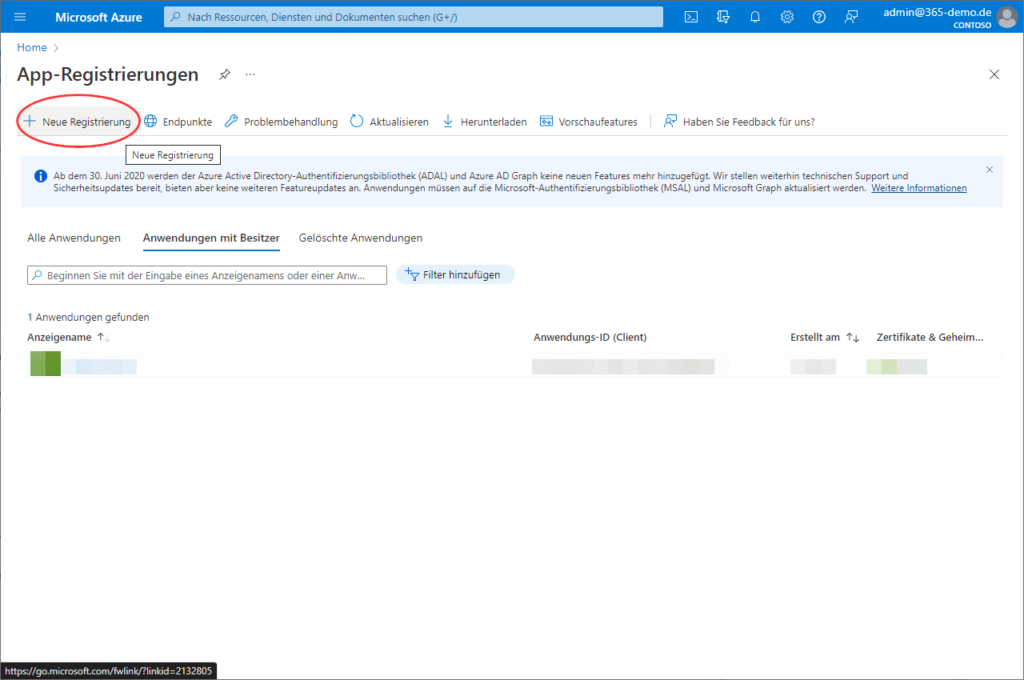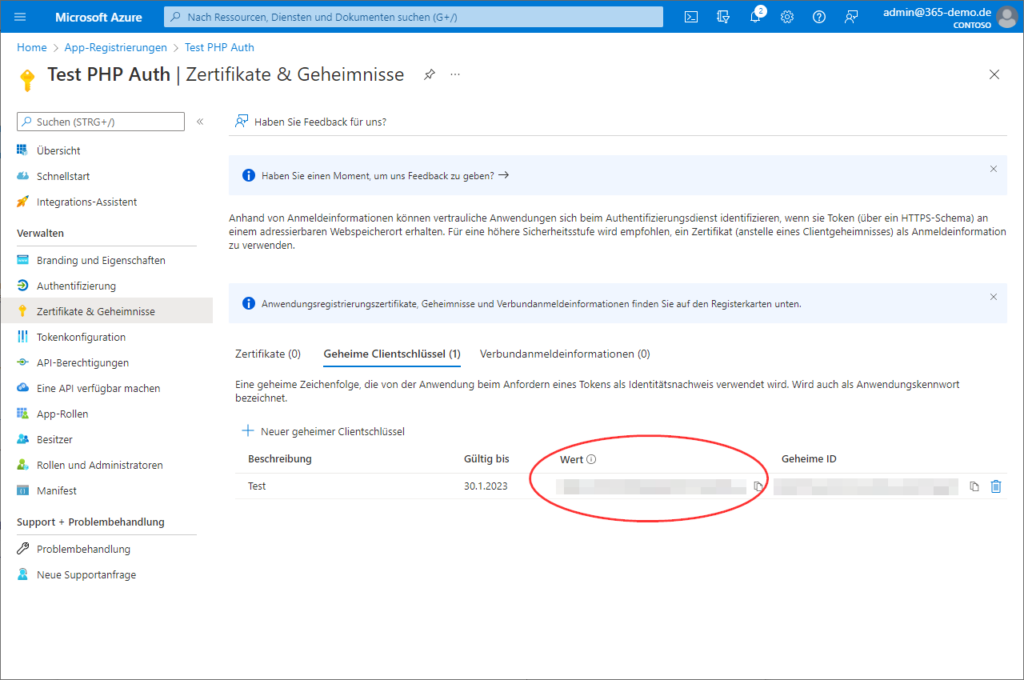Beispielcode für die Authentifizierung bzw. Anmeldung mit Microsoft / AzureAD / EntraID an einer eigenen PHP-Webanwendung. (Delegated Permissions)
Es zeigt lediglich die Basis, wie eine Anmeldung über Microsoft möglich ist. Dieser Code sollte nicht 1:1 in eine Produktivumgebung übernommen werden, da kein Errorhandling, etc. vorhanden ist. Einzelne Elemente zeigen jedoch, wie sich die Kommunikation aufbauen lässt.
Vorbereitung: App im Azure Portal registrieren
Gemäß den Schritten in den Screenshots unter https://portal.azure.com unter App-Registrierungen eine neue App erstellen, und App-ID als CLIENT_ID und Wert unter Schlüssel als CLIENT_SECRET in den PHP-Code übernehmen:
PHP Code
Folgenden Code im Webspace abgelgen und die REDIRECT_URI auf den Pfad der PHP-Datei anpassen. Dieser muss dem angegebenen Pfad der App-Registrierung entsprechen.
<?php // // very Basic oAuth2 Microsoft AzureAD/EntraID PHP PoC Example-Code // (c) Florian Neumann, 2022 // https://www.adminlabs.de/anmeldung-mit-microsoft-azuread-php-anwendung/ // // https://docs.microsoft.com/en-us/previous-versions/azure/dn645542(v=azure.100) // https://docs.microsoft.com/en-us/graph/api/user-get?view=graph-rest-1.0&tabs=http // $CLIENT_ID = "xxxxxxx-xxxx-xxxx-xxxx-xxxxxxxxxxxx"; $CLIENT_SECRET = "XXXXXXXXXXXXXXXXXXXXXXXXXX"; $REDIRECT_URI = "https://mydomain.tld/msoauth.php"; // // build and output Login-URL with App-Details // $parameter = http_build_query(array( "response_type" => "code", "client_id" => $CLIENT_ID, "redirect_uri" => $REDIRECT_URI )); echo "<a href='https://login.microsoftonline.com/common/oauth2/authorize?" . $parameter . "'>Login</a><br><br>";
// // if return Authorization Code by Microsoft, query Access Token // if($_GET['code'] != "") { echo "Authorization Code received: " . $_GET['code'] . "<br><br>"; $parameter = http_build_query(array( "grant_type" => "authorization_code", "client_id" => $CLIENT_ID, "client_secret" => $CLIENT_SECRET, "code" => $_GET['code'], "redirect_uri" => $REDIRECT_URI, "resource" => "https://graph.microsoft.com/" )); // // got Authorization Code, query Access Token from Microsoft with this code // $MSAADAuthSession = curl_init(); curl_setopt($MSAADAuthSession ,CURLOPT_URL, "https://login.microsoftonline.com/common/oauth2/token"); curl_setopt($MSAADAuthSession, CURLOPT_SSL_VERIFYHOST, 2); curl_setopt($MSAADAuthSession, CURLOPT_RETURNTRANSFER, TRUE); curl_setopt($MSAADAuthSession, CURLOPT_CUSTOMREQUEST, "POST"); curl_setopt($MSAADAuthSession, CURLOPT_VERBOSE, 0); curl_setopt($MSAADAuthSession, CURLOPT_POSTFIELDS, $parameter); curl_setopt($MSAADAuthSession, CURLOPT_HTTPHEADER, array('Content-Type:application/x-www-form-urlencoded')); $result = json_decode(curl_exec($MSAADAuthSession)); echo "HTTP Status-Code: " . curl_getinfo($MSAADAuthSession, CURLINFO_HTTP_CODE) . "<br><br>"; curl_close($MSAADAuthSession); var_dump($result); echo "<br><br>Access Token: " . $result->access_token . "<br><br><hr>"; // // got Access Token, query personal Details from GraphAPI // $MSGraphAPISession = curl_init(); curl_setopt($MSGraphAPISession, CURLOPT_URL, "https://graph.microsoft.com/v1.0/me"); curl_setopt($MSGraphAPISession, CURLOPT_SSL_VERIFYHOST, 2); curl_setopt($MSGraphAPISession, CURLOPT_RETURNTRANSFER, TRUE); curl_setopt($MSGraphAPISession, CURLOPT_CUSTOMREQUEST, "GET"); curl_setopt($MSGraphAPISession, CURLOPT_HTTPHEADER, array( 'Content-Type:application/json', 'Authorization: Bearer ' . $result->access_token )); $result = json_decode(curl_exec($MSGraphAPISession)); echo "HTTP Status-Code: " . curl_getinfo($MSGraphAPISession, CURLINFO_HTTP_CODE) . "<br><br>"; curl_close($MSGraphAPISession); // // Output User Details logged in // var_dump($result); echo "<hr>"; echo $result->userPrincipalName . "<br>"; echo $result->givenName . "<br>"; } ?>






